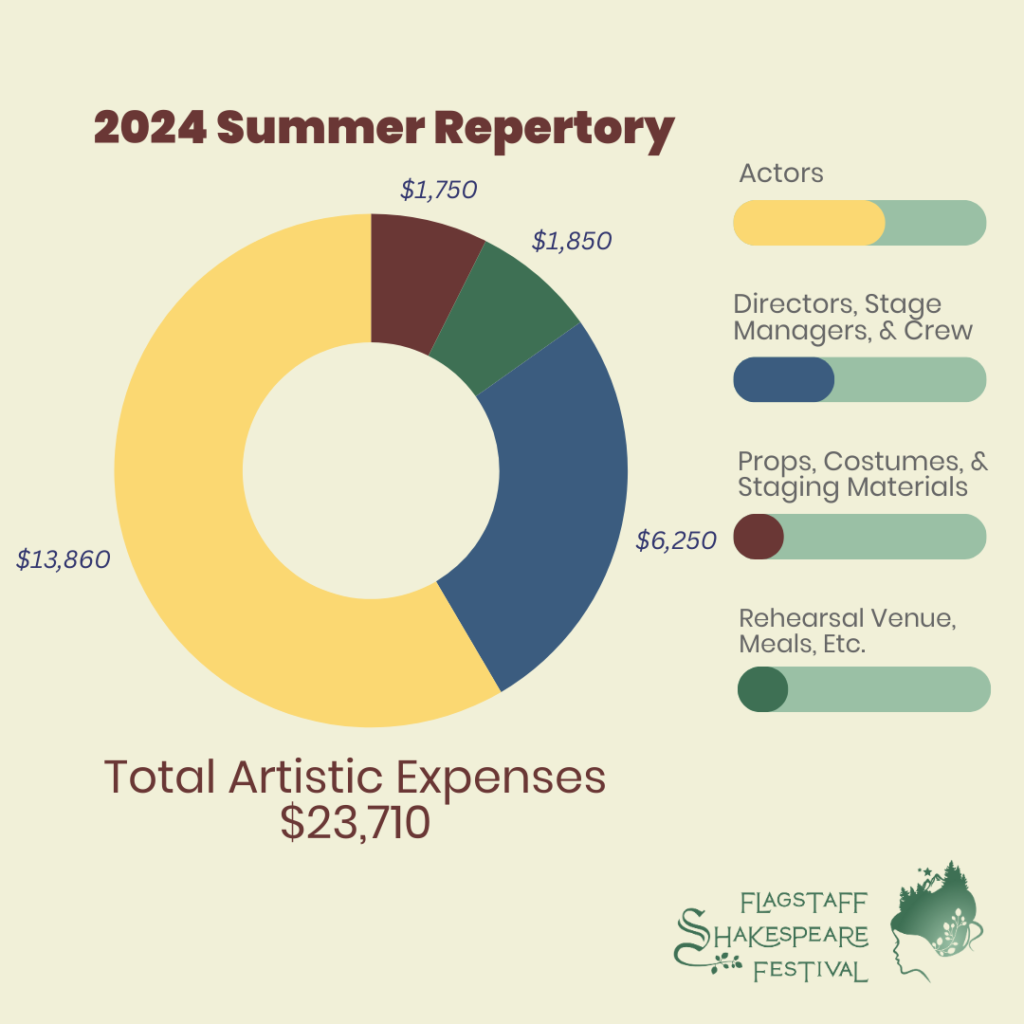As we wrap up our most successful summer season ever, we want to thank you for being an integral part of this journey. This year has been truly special, and we couldn’t have achieved so much without your incredible support.
Bringing Julius Caesar and The Merry Wives of Windsor to life under our festival tent at Lowell Observatory was a true pleasure. The setting was magical, and the response from you, our audience, was overwhelmingly positive. Your support allowed us to create unforgettable experiences and pay our talented artists more than ever before.
However, despite this season’s success, there’s still a gap between ticket sales and our overall costs. As the only professional theatre in Northern Arizona, we’re committed to maintaining the highest standards and supporting our artists, but we also see the importance of keeping ticket prices low.
Compared to our $30 general admission ticket, most professional theatre companies in Arizona charge between $50-$100 for their general admission tickets. Keeping our discount and youth tickets even lower and offering free senior matinees, pay-what-you-will previews, and school tours at just $200 per grade, we strive to make FlagShakes accessible.
Your donations help make all that possible. Recurring monthly donations are especially helpful in providing the stability we need to plan for future seasons and support our ongoing programs. (Link in bio)
Your continued generosity will make a significant difference, allowing us to keep delivering the quality performances you’ve come to expect and love.
Another way you can help is by taking a brief survey about what you want to see us produce next! These surveys help us gauge what programming is best for our community and how we can improve. (Link in bio).
Thank you for being such a vital part of our theatre community. We hope you can join us in celebrating 10 years of professional theatre in Northern Arizona by attending Lord and Lady Capulet’s Black, White, and Red Masquerade Ball on November 2!
Warmest thanks,
The FlagShakes Team
by Christine Schmidle, Director of Vision and Text, and Interim Executive Director, Flagstaff Shakespeare Festival
In 2023, I directed Flagstaff Shakespeare Festival’s seldom produced The Two Noble Kinsmen by
William Shakespeare and John Fletcher. What started out as a marketing challenge turned out to be an audience favorite! The company even had audience members come to see the production specifically to complete watching the canon.
Prepping the script for rehearsals, I noticed how ambivalent both Shakespeare and Fletcher were in their writing of this play. Fletcher more so than Shakespeare, but even Shakespeare kept his own opinion out of the text quite often. Discovering this opened up a lot more ways of understanding and seeing the play than I had originally thought. Emilia grew from an unidentified character to a young Amazonian who very much knew what she wanted throughout the rehearsal process. Surprisingly, Shakespeare and Fletcher‘s words supported that.
I had the immense fortune to work as Text Associate on the Shakespeare‘s Globe production of The Two Noble Kinsmen in 2018, directed by Barrie Rutter. This meant going into the FlagShakes production was possibly easier for me than many other directors discovering and directing this play. And yet, working on the play in Flagstaff opened up a whole new level of understanding. FlagShakes prides itself on being an actor led company and I think we discovered more in the rehearsal room because of this model. I don’t think I could have envisioned the feisty but firm interpretation of Emilia that our amazingly talented actor Audrey Young took on in this role. It’s a role that is almost impossible to read, and yet, put her on stage, give her some sass, and you have an Amazonian warrior breaking through the predetermined notions of the male-centric world of Athens.
While prepping for the production, I was determined to highlight the transcendence of the ages in Kinsmen. Costume designer Rin Hanovich created different worlds colliding and navigating on stage. I featured Chaucer in a newly added prologue, who appropriately was kept in Medieval costumes, followed by the steampunk nature of Athens. This collided with both the Rocker Babes of the Amazonians and the Adidas-wearing billionaires of Dubai, or rather, Thebes. The last group grounded the whole design: the tragic world of the working class of Athens–the Jailer and, in our case, her entourage – was in more traditional Renaissance costumes. What I liked about Rin’s interpretation was the visualization of the mind sets of these characters. Audiences could tell that both Arcite and Palamon were more interested in the Amazonians because both groups had modern dress, rather than the Jailer’s Daughter in her Renaissance garb. Audiences could also see the struggles of ‘steam punk’ Theseus having to negotiate with his new ‘biker’ bride Hippolyta, and his desire to get that knot tied before she might decide on a new lover.
I thought long and hard about how I wanted to portray Arcite and Palamon. Are these cousins possibly more to each other, lovers even? Besides the incestuous, I actually thought that taking that position would almost make this relationship easier to understand. I went for the harder decision and decided to keep them related and really good friends. But what does this mean, today, in our society? How do you portray a very close friendship between two young men, or rather boys, who have fought with each other countless times, are very comfortable with each other physically, and yet are not lovers? I was glad for the four weeks of rehearsal to establish this bond, and both Marcus Winn (Arcite) and Anthony Veneziano (Palamon) did an excellent job of showing that comfort level of closeness. What they also portrayed well was their constant competitiveness, climaxed in the scene where they are finally both in Emilia’s presence and get to confess their supposed love. ‘Forget I love her?’ says Palamon, and Arcite answers: ‘Though I think / I never shall enjoy her…’ (3.6) Although Emilia is right there in the scene, probably even in front of them, neither Arcite nor Palamon address her directly but are focused on their own competitiveness rather than impressing Emilia herself. What a wonderful and smart detail in this play; thanks Fletcher!
Audrey Young as Emilia gives a detailed view into her perspective of the character: “While Emilia’s opinion and sometimes actual presence, is overlooked by the male characters around her, she still stands strong in her thoughts and opinions. I believe this is best demonstrated in the scene mentioned above, when Arcite and Palamon battle for her hand in marriage. Alone on stage she makes it clear to the audience that she cannot decide between the two men and a little later, in the presence of Theseus, her opinion is still the same. She cannot be swayed by Theseus or her sister when it comes to taking a life simply because two men want her.”
In the rehearsal room, we came across this over and over again: Emilia’s words count. We found that Emilia’s line at the very beginning of the play: ‘If you grant not / my sister her petition … from henceforth I’ll not dare / to ask you anything, nor be so hard / ever to take a husband.’ (1.1) resonated through the play. There was a precedent set, something she had set herself and she was bound by her own word. It was those gems that we discovered together that made this play lift off of the page and the audience found joy and relevance in it. The production is “streamable” at flagshakes.org/flagshakes-films/
by Sonya Joseph
I’ve been seeing a lot of posts lately from my friends who work in theatre about what they are doing in light of the Black Lives Matter movement. Several have asked me for input. I haven’t really responded —I’m 53 years old, have been working in and around professional theatre, television, and film since my early 20’s, and frankly, they all could have listened earlier, asked for my input earlier, or just done better anytime over the last three decades.
Don’t get me wrong, it’s great to see theatre companies I’ve worked for in the past initiating conversations about diversity and starting Zoom readings of black plays (although as an Indian woman that doesn’t really help get me up on stage) but will any of these plays really see the light of day when the pandemic is over? Will actors of color get work? Breath not being held.
But, there remains the fact that I’ve had more than three decades of experience in this arena, so I do want to share my thoughts.
I’ve come up with a list of 10 things THAT WILL WORK to make the theatre (and film and television) a more diverse place.
- Audition actors of color. “But wait!” says every theatre in America, “we already do that.” Or they’ll say, “We invited them but nobody showed up!” In the mid 1990’s I heard this complaint from every artistic director in town. No. You did not invite them. You tacked on a statement about being “committed to inclusion, diversity, and providing equal employment opportunity” on to the end of the audition notice or added “all ethnicities encouraged to apply” as an afterthought. Eddie Levi Lee, of the marvelous Empty Space Theatre in Seattle, took my suggestions to heart and started wording casting notices with detailed information about what roles were open to color-blind casting, and it worked. Figure out what roles you are going to cast regardless of race, and put that information in the casting notice. Otherwise, don’t expect us to waste our time.
- Don’t debate; do. Back in the 90’s and 00’s, there was this great debate going on. August Wilson was all for people of color having their own theatres, their own plays, and just doing their own thing. There was another camp that was all about color-blind casting. And for years it has felt like getting the “right” answer to this debate had to happen before anything could change. So, until we know what is the right thing to do, let’s just play it safe and keep casting white people. C’mon people. Do. Both. Mount plays where playwrights of color create roles for actors of color, AND cast people of color in plays that have traditionally cast only white actors.
- Now here’s something that is going to help all actors: white, black, brown, and purple. Educate students and their parents about careers in the theatre. My poor father fought tooth and nail to keep me out of the theatre because, in his eyes, (and the eyes of pretty much everyone who doesn’t work in theatre) he envisioned me working for a pittance at a meaningless day job unless one day, by some luck of the draw, I managed to “become a star.” We all know that isn’t all there is. Regional theatre can pay quite well. Actors also work as writers, directors, teachers, producers, administrators, and more. I’ve made a good living at various points in my life from theatre alone, and no one would recognize my name. Can you imagine if we made these kinds of assumptions about doctors? As if only plastic surgeons were considered to have “made it” and every other kind of doctor was believed to be going door to door asking, “Hey, I’m a doctor, is anyone here sick?” That isn’t the reality and neither is the star scenario. We are a vital part of the economy, and this will only improve with greater diversity. And getting there starts with educating parents. We need their kids to help build more diverse communities of artists.
- We need to build audiences. Back in the day, one or two of the theatres in Seattle chose a play by a playwright of color, they cast actors of color, mounted the play, and nobody showed up. And then of course, that was the reason they never did it again. If you market only to white people who only like to see shows about other white people, you’re only going to get white people butts in your seats. I never saw a play until I was in my teens. Nobody thought to ask me. And let’s face it, if you have a more diverse audience, you are less likely to go belly up. If you build it, they will come. Hire marketing staff who are from diverse communities.
- Honor diversity funding. A friend of mine and I temporarily brought down a regional theatre in Seattle in the 90’s when we pointed out that a huge portion of their grant money came with stipulations that hiring be diverse. We can see the programs and photos of the homogenous actors and do the math. If you aren’t honoring these commitments, you are actually breaking the law. I would like to point out that there is funding, and thus success, to be found in hiring equality. Funding encouraging diversity exists for a variety of reasons:
• Hiring equality increases class equality
• Diverse representation leads to larger, more diverse audiences
• Diverse perspectives foster organizational strengths
- The unions need to create better programs to attract and retain actors of color. If the unions won’t let us audition, you, as individual theatres, will have to find a way to do it. I know that the union gives priority to people in the union for auditions, but since we are abysmally underrepresented, that leaves actors of color in the cold. Make sure you audition non-Equity actors, and that they proportionately represent our communities. And when actors of color DO get union status, those unions need to make waivers available so they can continue to work. I know many actors, including myself, who had to join a union for one specific job, and then we were prevented from taking non-union paying jobs with roles for actors of color because they were non-union. How does a union that throws up exponentially huge obstacles for people of color to join and then prevents us from taking paid work once we have joined serve us? Or the theatre as a whole?
- Media needs to continue highlighting the problem in positive ways. I came of age as an actor in the days of newspapers. It was obvious to me that the big theatres (doing big, white, classic shows) were on page 1 of the arts section, and the little scrappy, underfunded diverse theatres had a snippet on page 7. Giving airtime to theatres that are not part of the solution isn’t helping. Highlight diversity. Make it a priority in how you choose what plays and theatres and actors to feature and review. It’s been so unbalanced for so long, turn things upside down for a while. Make a theatre’s diversity policies and actions a criterion for front page status. But (and here’s the tricky part) don’t make it look like the problem is solved by never showing white actors. Like a college theatre program brochure that uses pics from that one production of Othello and that other production of The Wiz for 15 years to demonstrate how “diverse” they are.
- Diversity needs to be measured by screen and stage time, not payroll. If you hire a black stage manager, yeah, that’s great, but you don’t get a diversity chip for that. If you hire an actor of color for a one line role and throw the footage on the editing room floor, it doesn’t count. Yeah, she got paid for a day of work, but she won’t get residuals or a credit on IMDB, so it doesn’t matter.
- Recruit from local Shakespeare companies and ethnic theatre companies. Shakespeare, for some reason, doesn’t give a damn about the color of a person’s skin. There are a couple times when a white woman’s baby comes out unexpectedly black (oops) or a man’s dark skin is pointed out specifically, but aside from these few instances, Shakespeare seems to offer a wealth of opportunities for color-blind casting so actors of color tend to gravitate toward classical theatre. There are probably Latinx, African American, and Asian American theatre companies in your city. Know what your local Shakespeare and ethnic theatre companies are up to, and make sure your casting staff goes to see these productions. There’s no excuse for saying that you couldn’t find the right person. Seek, and you shall find.
- Respect the imagination. Sanford Meisner defined acting as, “living truthfully under imaginary circumstances.” The audience knows that these circumstances aren’t real. Trust them. They already gave you money to be there, so take them on a ride that includes imaginary circumstances like skin color not being an issue. Frankly, I’ve always wanted to play Blanche Dubois. And if you think an Indian woman knows nothing about living in a post-Civil War world, trying to make ends meet when society gives her very limited ways to do that and judges her when she steps out of bounds, then it’s you who knows nothing. I may be limited and constrained by this practice of casting by color, but really, just wait until you see what you’ve been missing.



